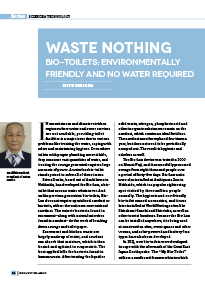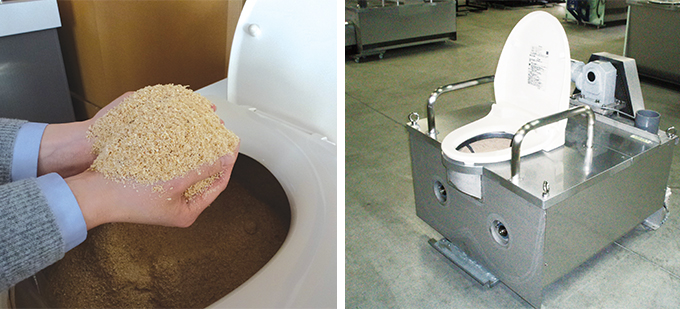Home > Highlighting JAPAN >Highlighting Japan March 2015>Science & Technology
Highlighting JAPAN

Science & Technology
Waste Nothing
Bio-toilets: environmentally friendly and no water required

IN mountainous and disaster-stricken regions where water and sewer services are not available, providing toilet facilities is a major issue due to various problems like treating the water, coping with odors and maintaining hygiene. Even where toilets with proper plumbing are available, they consume vast quantities of water, and treating the sewage generated
requires large amounts of power. A waterless bio-toilet stands poised to solve all of these issues.
Seiwa Denko, based out of Asahikawa in Hokkaido, has developed the Bio-Lux, a bio-toilet that uses no water whatsoever. And unlike previous generation bio-toilets, Bio-Lux does not require specialized sawdust or bacteria, either: the unit uses conventional sawdust. The enteric bacteria found in excrement—along with natural microbes found in sawdust—do the work of breaking down sewage and toilet paper.
Excrement and kitchen waste are largely made up of water, and sawdust can absorb that moisture, which is then heated and agitated to evaporate it. The heat applied kills the bacteria found in human waste. After treating the liquid or solid waste, nitrogen, phosphoric acid and other inorganic substances remain on the sawdust, which creates an ideal fertilizer. The sawdust must be replaced few times a year, but does not need to be periodically scooped out. The result is hygienic and odorless as well.
The Bio-Lux device was tested in 2000 on Mount Fuji, and it successfully processed sewage from eight thousand people over a period of forty-five days. Bio-Lux units were also installed at Asahiyama Zoo in Hokkaido, which is a popular sightseeing spot visited by three million people annually. The hygienic and eco-friendly bio-toilet caused a sensation, and it was later installed at World Heritage sites like Shirakami-Sanchi and Shiretoko, as well as other tourist locations. Because the Bio-Lux can be installed anywhere, it is being used at construction sites, event spaces and other venues, and solar-powered and battery-less types have also been developed.
In 2013, new bio-toilets were developed to cope with the aftermath of the Great East Japan Earthquake. The “My Bio-Toilet” utilizes a cardboard framework into which a plastic bag and sawdust are inserted. Offered as a set that includes plastic bags, sawdust and a plastic or wooden toilet seat (with lid), the unit retails for 29,000 yen. Inquiries have flooded in from around the country. The recently released temporary toilet unit specially designed for women, which provides a clean and comfortable space that can be used for touching up one’s makeup, has been gathering a lot of attention as well.
In addition, bio-toilets are drawing attention overseas. In developing countries with a severe lack of water, hygiene issues are a major problem; the water and sewage situation has a direct effect on people’s health. Seiwa Denko has thus taken part in an official development assistance project to purify the waters in Ha Long Bay in Vietnam, a World Heritage site, partnering with construction consulting firm Chodai. Waterless bio-toilets are being paired with a purification system to divide toilet and other sewage when processing it, creating a renewable system that does not require dedicated sewage plumbing.
“It may not be apparent in Japan, where water-based toilets are the norm, but sewage issues are an ongoing global problem,” says Toshihiro Kitsui, the president of Seiwa Denko. “It is likely that businesses in this area will continue to appear around the world.” He adds, “Only in times of disaster does this sewage issue come to the fore in Japan. If we consider the move toward a renewable society, however, we will have to be more proactive, and that includes developing new legislation.”
According to the Japanese Building Standards Act, only water-based toilets can be permanently installed in sewage-processing regions. In 2012, however, Japan added a new interpretation to these laws, allowing the installation of non-water-based toilets in such areas. This will likely lead to more bio-toilets appearing in Japan, as well as the advancement of the technology abroad. The spread of these bio-toilet units should also bring an increased awareness of environmental and disaster-related issues.
© 2009 Cabinet Office, Government of Japan






